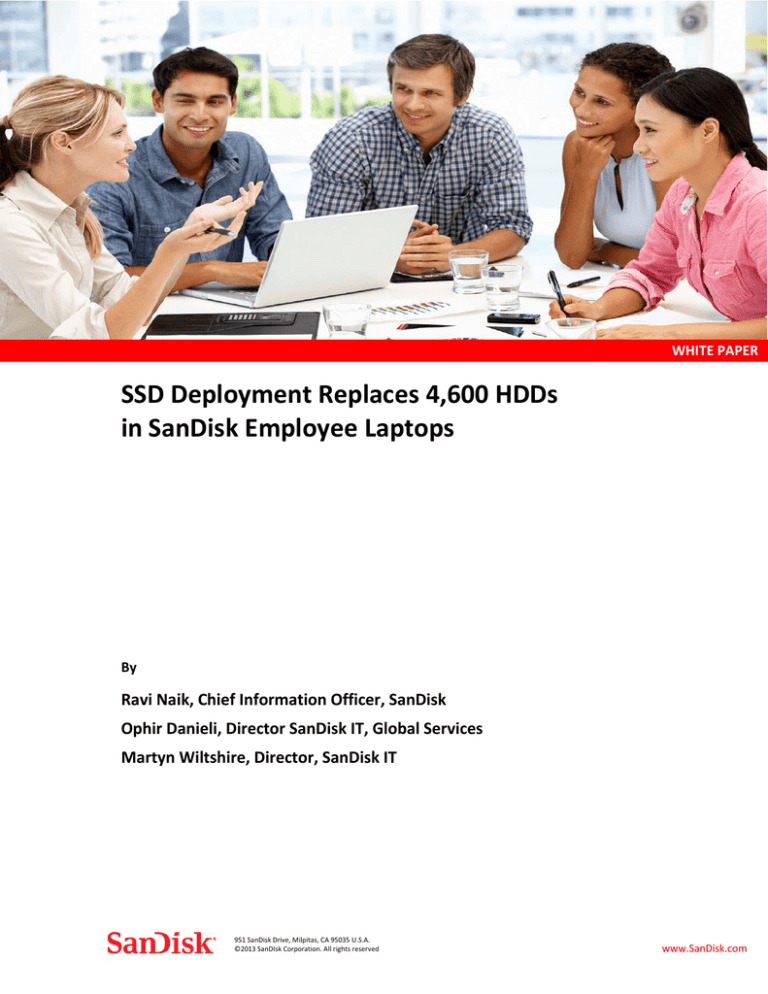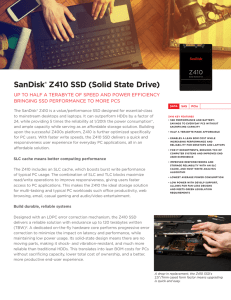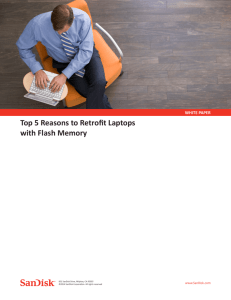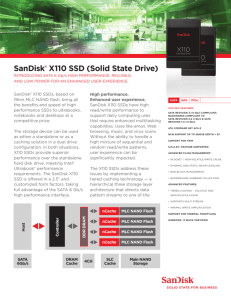
WHITE PAPER
SSD Deployment Replaces 4,600 HDDs
in SanDisk Employee Laptops
By
Ravi Naik, Chief Information Officer, SanDisk
Ophir Danieli, Director SanDisk IT, Global Services
Martyn Wiltshire, Director, SanDisk IT
Version 2
951 SanDisk Drive, Milpitas, CA 95035 U.S.A.
©2013 SanDIsk Corporation. All rights reserved
www.SanDisk.com
SSD Deployment Replaces 4,600 HDDs in SanDisk Employee Laptops
Table of Contents
Executive Overview
3
SSDs: The Future of Storage in Thin Clients
3
Scope of SanDisk SSD Program
6
Phase II: Pilot
6
Phase III—Standardization
7
Phase IV—Full Deployment
7
System Performance
7
Reliability and Endurance
8
Employee Satisfaction
9
Summary
12
2
SSD Deployment Replaces 4,600 HDDs in SanDisk Employee Laptops
Executive Overview
SSDs: The Future of Storage in Thin Clients
Solid state devices (SSDs) are rapidly transforming the storage
landscape, as Chief Information Officers (CIOs) accelerate their
adoption of flash technology in the enterprise, including thin
client upgrades of corporate laptops. As a truly disruptive
technology with a proven Return on Investment (ROI), SSDs are
capturing significant market share from the hard disk drives
(HDDs) they replace. As businesses continue to fight to remain
relevant in this competitive landscape, CIOs of Fortune 1000
companies will lead the way.
CIOs have long recognized the dramatic and indisputable
performance advantages of software-enabled SSDs over HDDs.
1
Estimates are that SSDs outperform HDDs by 15X . The SSD
value proposition has now been further strengthened with the
emergence of compelling and verifiable secondary SSD benefits
that reduce Total Cost of Ownership (TCO) and boost ROI.
SSD Deployment
Performance Highlights*
• Disk Encryption process is > 60%
faster than HDD
• SSD measured failure rate < 0.1%
• SSD boot time 20 seconds vs. 44
seconds for HDD, for a 46%
improvement
• SSD shutdown time is 12 seconds
vs. 21 seconds for HDD, or 58%
faster
• Improved battery life by 20% over
HDD
• OS deployment 30% faster
• Virus scan was 306% faster with
SSD vs. HDD
• File write was >400% faster with
SSD vs. HDD
• Microsoft Excel took 11.6 seconds
to load with SSD vs. 19.77 seconds
with HDD
• Re-image time reduced by > 30%
*Based on average benchmark scores.
CIOs can improve laptop performance, lower IT costs, extend
the lifecycle of the laptop, improve employee productivity and
dramatically improve the user experience by upgrading their current inventory of laptops and retrofitting them with
SSDs. SanDisk IT did just that.
The SanDisk SSD Upgrade Initiative
Over an eight-month period in 2013, SanDisk IT replaced HDDs with SSDs in 4,600 corporate laptops used by
SanDisk employees worldwide. This upgrade initiative was the end result of a process that actually began two years
earlier with benefit reviews and initial research, driven by a defined goal to provide employees with improved
computer performance. Another secondary objective, equally important, was the opportunity to verify compelling
benefits generally associated with SSDs. They include:
1 1
As compared to 7200 RPM SATA 2.5” hard drive. Based on published specifications and internal benchmarking tests.
3
SSD Deployment Replaces 4,600 HDDs in SanDisk Employee Laptops
•
2
Extending laptop lifecycles by 33% from three years to
four years. In SanDisk’s case, this can defer approximately
$1.84 million each year and enables the delay of new
laptop purchases until next generation processors and
graphics are available
•
3
Increasing employee productivity by 35% with nearlyinstant access to applications and increased uptime due to
improved reliability
•
Since the SSD deployment, SanDisk benchmark tests
showed that employees saved 24 seconds of unproductive
time in faster boot process and 9 seconds in faster
shutdown time.
•
4
Improving battery life by 20% , which is a significant
productivity benefit for mobile employees who travel
regularly
•
Increased reliability and endurance since SSDs consume
SSD Deployment
Business Highlights
• SSDs increased laptop lifecycle by
33%, from 3-4 years to 4-5 years
• Increased laptop uptime and higher
productivity due to longer battery
life
• Users gained on average 15
minutes productive time per day
(i.e. instant access, smooth multitasking, faster boot and shutdown
times)
• Help Desk hardware related tickets
declined from 8.5% of all cases to
3.5%
• Total Cost of Ownership: SSD
deployment results in annual cost
reduction and deferred savings of
up to $610 per laptop*
low power, generate little heat and have no moving parts
•
Improving the user experience because small form factors
*Based on
estimates.
IDC
findings
plus
SanDisk
allow for ultra-thin and light laptops for convenient
mobility
•
5
An 86% reduction in annual IT labor costs to evaluate, fix, and repair crashed or improperly working disks and
recover lost data
•
The frequency of hardware-related service tickets alone issued by SanDisk's Global IT Help Desk has declined
59% since the beginning of the SSD deployment, from 8.5% of all Help Desk cases to 3.5%
When all factors are considered, SSDs help IT organizations drive a substantial reduction in TCO and a higher ROI.
SSDs: Total Cost of Ownership
When comparing the cost of an SSD against a traditional HDD, CIOs may be tempted to select a lower-cost HDD
solution. However, SanDisk IT documented an overall lower TCO after verifying the benefits of deploying SSDs in all
of its corporate laptops. SanDisk estimates total cost reduction and deferred savings of up to $610 per laptop when
HDDs are replaced by SSDs. This is achieved by extending SSD-equipped laptop lifecycles by one year, from three
years to four years, resulting in deferred spending of approximately $400 per laptop per year (see Figure 1). In
2
SanDisk estimate
IDC: "The Total Cost of Ownership of a SSD-Enabled PC" ( July 2011)
4
SanDisk Investor Presentation, May 8th 2013
5
IDC: "The Total Cost of Ownership of a SSD-Enabled PC" ( July 2011)
3
4
SSD Deployment Replaces 4,600 HDDs in SanDisk Employee Laptops
addition, a 2011 IDC study cites an annual savings of up to $210 per SSD-equipped PC due to lower failure rates,
lower power consumption, longer battery life and higher performance (see Figure 2).
With 4,600 corporate laptops, SanDisk is able to defer spending approximately $1.84 million per year. Due to the long
life of SSDs, the devices can easily be erased by IT and re-used, resulting in additional savings.
Figure 1. SSDs Defer IT Spending
Cost of a laptop: $1,500/3*
=$500/year
SSD cost minus
value of hard
drive= $100
Total deferred
spending/laptop*:
$500-$100=$400
*assumes refresh
delay of one year
* assumes 3-year lifecycle
Approximate figures based on SanDisk estimates
Figure 2.
Annual Savings per PC with an SSD
Lower failure rates
$70
Extended laptop lifecycle
$400
Higher performance
$93
Longer battery life
$45
$610
Total Savings
Lower power consumption
$2
SanDisk internal testing demonstrates that performance is greatly enhanced when comparing a SanDisk SSD with a
256GB* HDD, resulting in PC performance that was 15X better than the one with a HDD.
Increased SSD I/O performance can also reduce re-image and OS deployment time. Since imaging takes 30 minutes
less with an SSD than the same machine running a HDD, SanDisk IT estimated that for imaging it saved approximately
6
3,000 productive hours in 2012. In addition, the faster performance of SSDs reduced disk encryption time by about
60%. Because re-imaging and disk encryption were accomplished at the same time, end users were without their
6
Based on performing 6000 re-images and new OS deployments
5
SSD Deployment Replaces 4,600 HDDs in SanDisk Employee Laptops
laptop for only 1.5 hours. By contrast, the same process would have taken at least three times longer as compared to
a 7200 RPM HDD 7.
Because SSDs are lower power and generate minimal heat, a laptop battery will hold its charge 20% longer and will
need to be replaced less frequently than with a HDD. This lowers replacement costs and reduces IT Help Desk service
support. The benefit for the end-user is the ability to work longer without interruption, and with less down-time,
which is especially important for mobile employees who travel frequently for business.
With no moving parts, SSDs can withstand jarring movements, and laptop reliability is enhanced dramatically. Unlike
HDDs, which are prone to breakdown, SanDisk IT observed that the likelihood of SSD data loss and failure is remote. In
8
fact, the measured failure rate of SSDs in use at SanDisk is < 0.1% .
Scope of SanDisk SSD Program
SanDisk IT is responsible for the company's global data infrastructure strategy as well as the maintenance and support
of the company's computer systems around the world. Of its nearly 5,000+ employees in 18 countries worldwide,
4,600 required SSD upgrades to their corporate laptops. After months of planning and testing, the decision was made
to swap out SATA HDDs with SanDisk X110 SSDs in all of these computers.
The Decision to Move Forward
SanDisk's decision to embark on this important initiative was made after a careful benefit review and pilot study of
performance improvements, and the projected secondary benefits. The SSD worldwide deployment program was
spearheaded by IT and consisted of four distinct phases.
Phase I: Benefit Review and Initial Research
The goal of Phase I was to clearly establish guidelines in order to measure the primary and secondary
benefits of deploying SSDs to ensure a reduction in the TCO and a meaningful increase in ROI for SanDisk IT
and the corporation.
During this planning phase, SanDisk IT set the parameters for the SSD deployment, selected benchmark
standards to measure performance, and estimated the cost and time required by both IT and SanDisk
employees to complete the program.
Phase II: Pilot
A pilot group of employees from business groups around the world participated in Phase II. The established
goals:
7
SanDisk benchmark results based on SanDisk X110 SSD 256GB vs. HDD 250GB, 7200RPM
SanDisk benchmark data from SanDisk X110 SSD upgrade project
*1 GB = 1,000,000,000 bytes. Actual user capacity less.
8
6
SSD Deployment Replaces 4,600 HDDs in SanDisk Employee Laptops
•
Prove clear ROI
•
Measure TCO and SSD benefits, including performance against installed HDDs
•
Establish protocols for SSD ordering, distribution around the world, and support/training and
documentation.
The employees who were part of the pilot were asked to leave their computers with IT for no more than
three hours. As an extra measure of precaution, all of the hard disk drives were catalogued and securely
stored after the HDD data was transferred to the SSDs. Most IT laptops were upgraded with SSDs during this
initial phase.
Phase III—Standardization
With the initial success of the pilot, the company made the decision to create a company-wide corporate
laptop SanDisk SSD standard. Plans were put in place for full deployment, and, in addition, SanDisk IT worked
with major computer manufacturers to deploy SanDisk SSDs as part of the Customer Factory Integration (CFI)
process for all new laptops purchased for SanDisk internal use.
Phase IV – Full Deployment
In Phase IV, SanDisk IT was responsible for the execution of the program in all locations, except in the very
small (one or two employees) global offices without IT personnel. In these cases, a point of contact was
provided with precise instructions and, where needed, they would work remotely with IT engineers. In
locations with IT employee(s), the swap-out cycle time improved to no more than 1.5 hours, and employees
generally dropped off their laptops and retrieved them – loaded with their fully encrypted new SanDisk SSDs
(most employees received the SanDisk X110 SSD, 256GB). The full rollout, to 4,600 employees, took about 20
weeks.
System Performance
It is well known that SSDs have clear system performance advantages compared with HDDs, including instant access
to data and dramatically faster application loading. To verify these performance advantages, SanDisk IT used industrystandard benchmarking tools to compare the performance of SSDs against HDDs. SanDisk IT ran manual and
automated performance tests with the PCMark05 benchmarking tool on machines with HDD, and the same tests on
the same machine, running the same operating system (Windows 7), after cloning the HDD content to SSD (see Figure
3).
7
SSD Deployment Replaces 4,600 HDDs in SanDisk Employee Laptops
Figure 3
SSDs Accelerate Application Loading
40
SanDisk X110 256GB
Hitachi 7200 500GB
35
Seconds
30
25
20
15
10
5
0
Adobe®
Reader®
Google®
Picasa®
Adobe®
Photoshop®
Copy files
Microsoft®
Excel®
Zip files
SanDisk IT tested several laptop models with different processor types, RAM size and HDD models. In most tests—
overall workloads, productivity workloads, and I/O workloads—the SSD-equipped system significantly outperformed
the HDD-equipped system (see Figure 4, next page).
Reliability and Endurance
Reliability and endurance impact TCO. With a capacity to write and erase data repeatedly with little or no loss in
performance, and no moving parts to break or wear out, SSDs can often outlive the usefulness of an older corporate
laptop. In such cases, the SSD can be re-used in a next-generation laptop with faster processors and improved
graphics capabilities. Aside from wearing out or breaking down with repeated use, HDDs are more prone to crashes
because its mechanical parts are vulnerable to vibrations, jarring or dropping of a laptop. Because employees are
highly mobile, travel for business and take their laptops home, the risk of damaging the HDD increases.
8
SSD Deployment Replaces 4,600 HDDs in SanDisk Employee Laptops
Figure 4
(Source: SanDisk Benchmark data)
Benchmarks conducted on 104 different systems with 250GB HDD, 7200RPM and then again after upgrading to
SanDisk X110 SSD 256GB. All tests conducted using PCMark05®.
Performance Benchmark
Boot Time (seconds)
Shutdown Time (seconds)
Windows 7 Disk Score
PCMark05 Score
HDD - Virus Scan (MB/s)
HDD - File Write (MB/s)
OS Deployment (hh:mm:ss)
Disk Encryption (hh:mm:ss)
HDD
• A rapidly spinning magnetic disk encased in metal
with a mechanical arm that physically moves
across the disk to retrieve data
• HDD is thick and heavy and typically has two
motors, which adds to weight and thickness of the
laptop
• Generates substantial amount of noise
• HDDs generates significant amount of heat,
affecting battery life
• Moving parts make HDD prone to breakdown and
crashes, causing lost productivity and possible
data loss
• Latency delays slow down speed of access to data
on HDD
• Performance deteriorates and latencies increase
as the mechanical arm searches, reads and writes
data on the disk.
• Performance suffers as more and more data is
added
HDD
250GB
44
21
5.6
4576.2
76.56
62.42
01:27:09
03:47:00
SanDisk X110 SSD
256GB
20
12
7.9
35142.4
234.30
254.75
01:01:50
01:25:00
SanDisk X110 SSD
Performance Gain
55%
43%
41%
668%
206%
308%
29%
63%
SanDisk SSD
• A thin, rugged, lightweight semiconductor
storage device
• Small and lightweight form factor enables
slim and lightweight laptops ideal for mobile
workforce
• With no moving parts to break down, drive
reliability is improved and failure rates are
rare
• Boot times, read/write latency and
application loading are a fraction of a HDD,
which improves employee productivity and
satisfaction
• Provides instant access to data and ultra-fast
application loading times with low latency,
and is ideal for multi-tasking
• Consumes minimal power and stays cool,
extending battery life
• Generates no noise and minimal heat,
extending life of laptop
• Performance is sustained, even as more data
is stored
9
SSD Deployment Replaces 4,600 HDDs in SanDisk Employee Laptops
Employee Satisfaction
Nearly 20% of the 4,600 SanDisk employees whose laptops were retrofitted with SSDs, responded to a survey
conducted near the end of the SSD deployment.
Almost 93% of respondents said they saw improvements in their user experience and productivity as a result of
the SanDisk SSD retrofit, with nearly 56% reporting “significant improvement.”
93% of employees reported “good, very good and excellent” overall satisfaction with the performance of their
corporate laptop since it was equipped with a SanDisk SSD (see Figure 5, next page). As for the retrofit process
itself, 83% of respondents reported that retrofitting their corporate laptops with a SanDisk SSD was “easy” with
65% saying it was either “very easy” or “with no issues whatsoever" (see Figure 6, next page).
SanDisk employees expressed overwhelming satisfaction with the performance of their corporate laptops and
reported improved user experience and productivity. They said overwhelmingly that the SanDisk SSD is the most
effective laptop hard drive for them (see Figure 7, page 12).
On a scale 1-5, 5 being excellent,
how would you rate your overall
satisfaction with the performance
of your corporate laptop since it
was equipped with an SSD?
Figure 5
Poor
Fair
1.41%
5.38%
Excellent
25.38%
25.90%
Good
41.92%
Very good
10
SSD Deployment Replaces 4,600 HDDs in SanDisk Employee Laptops
N= Figure 6
On a scale 1-5, 5 being excellent,
how easy was the process for you
when your corporate laptop was
reconfigured with a SanDisk SSD?
It was very difficult for me
2.07%
14.75%
29.11%
It was OK
No issues whatsoever
17.98%
It was fairly easy
36.09%
It was very easy
Which is the most effective storage
solution for you?
Figure 7
HDD
3.09%%
83.14%
13.77%
No opinion
SanDisk SSD
11
SSD Deployment Replaces 4,600 HDDs in SanDisk Employee Laptops
Summary
Today’s highly mobile workforce requires fast laptop connectivity, instant access to business data, smooth multitasking and batteries that won’t quit on a cross-country plane trip. The laptops must be ultra-lightweight yet rugged,
cool and quiet, and provide predictable sustained performance with minimal downtime. SSDs, with their many
advantages over HDDs, help make all of this possible.
To meet the needs of its own workforce, SanDisk IT upgraded its pool of 4,600 corporate laptops around the world
with high-performance SanDisk X110 SSDs to replace aging and sluggish HDDs.
As a global company operating in 18 countries, SanDisk's initiative to replace HDDs with SSDs had inherent logistical
challenges. SanDisk's nearly 5,000 employees use laptops in the everyday execution of their jobs and to the casual
observer, the process to install SSDs appeared to be a formidable, if not daunting, task. A small SanDisk IT team
managed the process systematically and methodically without creating business disruption. The end result? SSDs
improved business tools for its employees, lowered the TCO for the corporation, and served as a proof of concept that
can be applied to virtually any company.
©2013 SanDisk Corporation. All rights reserved. SanDisk is a trademark of SanDisk Corporation, registered in the United States and other countries.
** 1GB = 1,000,000,000 bytes. Actual user capacity less.
12



